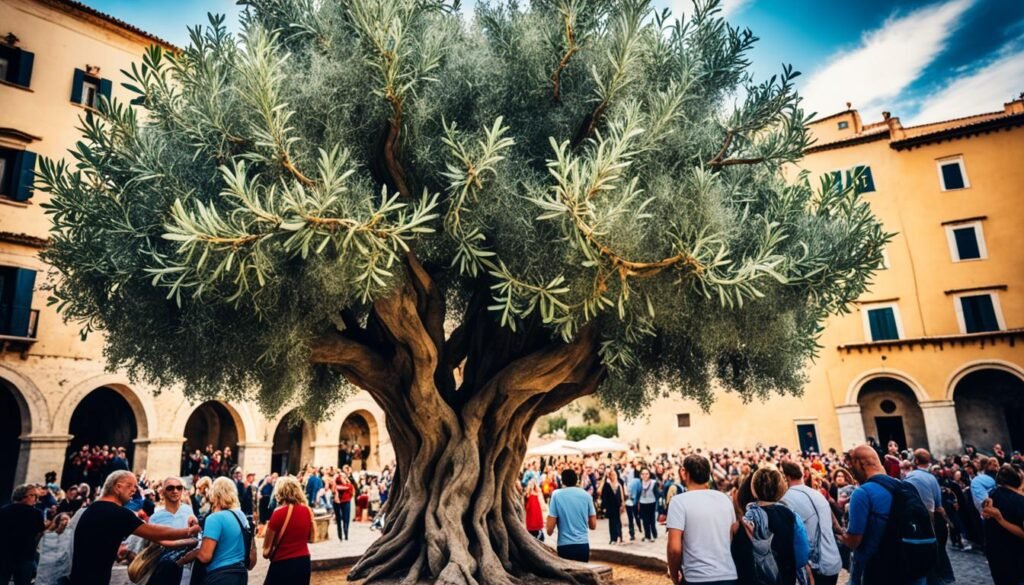Ancient myths and legends have captivated civilizations throughout history. From the tales of ancient Greece to the epic stories of Norse mythology, these legends have shaped cultures and inspired countless works of art and literature. Let’s explore some of the most famous ancient myths and legends that continue to captivate our imagination.
Theogony: Clash of the Titans
According to Hesiod’s Theogony, the world was born out of Chaos, encompassing the creation of the Earth, mountains, sea, and sky. In this epic tale, the Titans, formidable deities, emerged from the union of Uranus and Earth. Among them, Cronus, the most powerful, rose to prominence by overthrowing his father Uranus and assuming the role of world leader. The Titans, however, were eventually defeated in the Titanomachy, a fierce battle against the gods, and were cast into the depths of Tartarus. This marked the rise of Zeus, who emerged victorious and became the ruler of the world.
“The world was born out of Chaos, with the Earth, the mountains, the sea, and the sky.”
Zeus, the supreme deity, established his domain on Mount Olympus, ascending to divine power and authority. As the ruler of gods and humans, Zeus brought order and stability to the world, overseeing the affairs of both mortals and immortals.
The Theogony also narrates the great conflict known as the Gigantomachy, where the gods confronted the Giants. Despite the Giants’ formidable strength and monstrous nature, Zeus and his divine allies emerged victorious, solidifying his position as the leader of the gods.
Throughout the Theogony, the clashes between the Titans, gods, and Giants symbolize the eternal struggle for power, the rise and fall of civilizations, and the establishment of divine order. These epic battles and the subsequent ascendance of Zeus to Mount Olympus are pivotal events in Greek mythology, shaping the hierarchy of the gods and the destiny of the world.
The Creation of the World
According to Hesiod’s Theogony, the Greek world was born out of Chaos – a primordial void from which everything originated. From Chaos emerged Gaia (Earth), Tartarus (the deepest parts of the underworld), Eros (Love), and Nyx (Night). These elemental forces set the stage for the subsequent creation and emergence of the gods, Titans, and other significant figures in Greek mythology.
The Rise of the Titans
Following the initial creation, the Titans were born from the union of Gaia and Uranus, the sky. The Titans were a powerful and ancient race of deities who ruled during the Golden Age. They were associated with various aspects of the physical world, such as the sun, the moon, and the natural elements.
The Titanomachy and Gigantomachy
The Titanomachy was a fierce conflict between Zeus and the Olympian gods against the Titans. The gods emerged triumphant, banishing the defeated Titans to Tartarus, a gloomy and abyssal realm within the underworld.
In the Gigantomachy, the gods waged war against the Giants, monstrous creatures born from the blood of Uranus. The gods defeated the Giants, reinforcing their dominion over the universe and further solidifying Zeus’s supremacy.
Establishing Mount Olympus
After their victory in the Titanomachy and Gigantomachy, Zeus and the gods secured their dominion, establishing Mount Olympus as their celestial abode. This mythical mountain became the center of divine power, serving as the gathering place for the twelve Olympian gods and goddesses.
“The Titanomachy and Gigantomachy marked the rise of Zeus as the ruler of the world.”
Theogony, with its tales of creation, divine conflicts, and the rise of Zeus, provides the foundation for the rich tapestry of Greek mythology. These stories have captured the imagination of generations and continue to serve as a source of inspiration and enduring fascination.
The Three Sisters of Fate

In Greek mythology, the Moirae, also known as the Three Sisters of Fate, played a crucial role in shaping the destiny of both humans and gods. These three powerful goddesses were responsible for weaving the thread of life and determining the ultimate fate of each individual.
The Three Sisters of Fate consisted of Clotho, Lachesis, and Atropos. Clotho, the youngest sister, possessed the important task of spinning the thread of life. She carefully crafted the thread, symbolizing the beginning of each person’s journey through life.
The thread created by Clotho was then passed to Lachesis, the second sister. Lachesis allocated the fate of individuals, deciding the course of their lives, the challenges they would face, and the choices they would make. She carefully measured and determined the length of the thread, representing the duration of each person’s life.
Finally, the thread reached Atropos, the eldest sister. Atropos was responsible for cutting the thread, signifying the end of someone’s life and their inevitable death. She held the power to determine how and when someone would meet their ultimate demise.
The Three Sisters of Fate, with their individual roles, personified the concepts of fate, destiny, and mortality in ancient Greek mythology. They were seen as the arbiters of life and death, guiding the course of human existence.
“Clotho, Lachesis, and Atropos, the Three Sisters of Fate, were the weavers of life’s tapestry, deciding the fate of all living beings.” – Greek Mythology
Their significance in Greek mythology is evident in various stories and tragedies, where the actions of humans and gods alike were ultimately determined by the thread of life spun by the Three Sisters of Fate.
The Three Sisters of Fate Table:
| Name | Role |
|---|---|
| Clotho | Spun the thread of life |
| Lachesis | Allocated fate and measured the length of life |
| Atropos | Cut the thread, determining the manner of death |
Prometheus and the Theft of Fire
In Greek mythology, Prometheus, a powerful Titan, defied the gods by stealing fire and giving it to humans. This act of compassion angered Zeus, the king of the gods, who sought to punish Prometheus for challenging the natural order of things.
Zeus devised a cruel punishment for Prometheus. He chained Prometheus to a rock and sent an eagle to eat his liver every day, only for it to regenerate overnight. This tormenting cycle continued for years, causing immense suffering for Prometheus.
The myth of Prometheus and the theft of fire represents the eternal struggle between humans and the gods. Prometheus’s actions brought a divine gift, the fire, to humanity, allowing them to progress in civilization and improve their quality of life. However, this act of defiance also came with severe consequences.
“Prometheus, while you outwit my power,
we shall not be equals.
One day you shall learn what it is to be at odds with Zeus!”– Zeus to Prometheus, from Hesiod’s “Theogony”
The theft of fire symbolizes the balance between progress and punishment. In giving fire to humans, Prometheus granted them the means to develop and advance, but also aroused Zeus’s wrath and subjected himself to eternal anguish.
Furthermore, fire represents more than just a physical element in this myth. It embodies knowledge, creativity, and the capacity for change. Prometheus’s act not only bestowed fire upon mankind but also ignited the spark of innovation and potential within human consciousness.
The Significance of Fire in Prometheus’s Act of Compassion
In ancient times, fire was a crucial element in human survival, providing warmth, light, protection, and the ability to cook food. Through Prometheus’s gift, humans acquired the power to forge tools, advance in agriculture, and make technological advancements. Fire became a catalyst for progress and a symbol of human ingenuity.
However, the consequences of Prometheus’s actions cannot be ignored. His punishment serves as a reminder that defying the gods and challenging the natural order inevitably leads to severe repercussions.
Prometheus’s act of stealing fire and his subsequent punishment are powerful metaphors that explore the complexities of human ambition and the pursuit of knowledge. It raises philosophical questions about the price of progress, the boundaries between mortals and immortals, and the balance between divine control and individual freedom.
The Legacy of Prometheus’s Myth
The myth of Prometheus and the theft of fire has continued to captivate audiences throughout the centuries. It has inspired numerous literary works, paintings, and sculptures that seek to explore the moral dilemmas and existential implications embedded within the myth.
Prometheus’s defiance and his determination to challenge authority resonate with the human desire for autonomy, progress, and the pursuit of knowledge. His story stands as a testament to the power of individual agency and the consequences of challenging the established order.
Our fascination with Prometheus and his act of stealing fire reflects our collective fascination with the complexities of human nature and our ceaseless quest for enlightenment.
| Key Elements of Prometheus and the Theft of Fire Myth | Meaning and Symbolism |
|---|---|
| Fire | Knowledge, progress, potential, innovation |
| Zeus | Divine authority, punishment, wrath |
| Humanity | Ambition, curiosity, mortality, ingenuity |
| Conflict | Struggle between mortals and immortals, defiance vs. divine order |
Pandora’s Box
In Greek mythology, Pandora was the first woman created by the gods. Zeus gave her a box and warned her not to open it under any circumstances. However, curiosity got the better of Pandora, and she opened the box, releasing all the evils into the world. Only Hope remained inside the box. The myth of Pandora’s Box serves as a cautionary tale about the consequences of giving in to curiosity and the importance of hope in a world filled with troubles.
The Abduction of Persephone by Hades
Persephone, the daughter of Demeter and Zeus, was abducted by Hades, the god of the Underworld. This myth explains the changing of the seasons. When Persephone is in the Underworld, her mother Demeter mourns, and the earth becomes barren. When Persephone returns to the surface, Demeter rejoices, and the earth blossoms once again.
According to the myth, Zeus granted Hades permission to marry Persephone without her mother’s consent. One day, as Persephone was picking flowers in a meadow, Hades emerged from the ground in a chariot and abducted her to the Underworld. Demeter searched frantically for her daughter, causing great suffering on earth.
Hades eventually allowed Persephone to return to the surface, but before she left, he tricked her into eating a few pomegranate seeds. The consumption of these seeds bound Persephone to the Underworld. It was then decided that Persephone would spend one-third of the year with Hades, representing winter when the earth is barren. The other two-thirds of the year, she would be with her mother, Demeter, representing spring and summer when the earth flourishes.
This myth holds great significance in explaining the changing seasons. When Persephone is in the Underworld, her absence brings about winter, symbolizing Demeter’s sorrow and the barrenness of the earth. But when Persephone returns to the surface, Demeter’s joy is reflected in the rejuvenation of the earth and the arrival of spring.
The Abduction of Persephone is also intimately linked to the Eleusinian Mysteries, ancient secret religious rites held in Eleusis, Greece. These rituals celebrated the harvest and the cyclical nature of life and death. The myth of the Abduction of Persephone, with its themes of loss and regeneration, played a central role in these ancient ceremonies.
The Seasons and the Abduction of Persephone
| Season | Persephone’s Location | Effect on Earth |
|---|---|---|
| Spring/Summer | With Demeter on Earth | Earth blossoms and flourishes |
| Autumn | Preparing to return to the Underworld | Earth transitions, preparing for winter |
| Winter | With Hades in the Underworld | Earth becomes barren and desolate |
The Name Giving of Athens
According to Greek mythology, Athens received its name through a competition between Poseidon, the god of the sea, and Athena, the goddess of wisdom. Cecrops, the first king of Athens, allowed the people to choose the winner by deciding which gift was more valuable.
Poseidon struck a rock with his trident, creating a spring of salty water. Meanwhile, Athena made an olive tree grow from the ground. The people of Athens were faced with a decision: a spring of salty water or an olive tree, which came with abundant benefits.
The people chose Athena’s gift of the olive tree as it provided not only food, but also oil and firewood. The olive tree became a symbol of peace, prosperity, and civilization. It was a practical and enduring gift that brought numerous benefits to the city and its inhabitants.
“The people of Athens recognized the value of the olive tree, not just as a source of sustenance, but as a symbol of fertility, peace, and prosperity. They saw the wisdom in choosing Athena’s gift over Poseidon’s.”
This momentous decision made Athena the patroness of Athens. The city was named after her, demonstrating the recognition of her wisdom and the importance of her gift in the lives of the people. The olive tree became a prominent symbol of Athens and its thriving civilization.
Today, the Name Giving of Athens myth serves as a reminder of the significance of choosing practical and beneficial gifts over grandiose but less useful ones. It underscores the value of wisdom, sustainability, and the long-term benefits that come from making thoughtful choices.
| Gift | Benefits |
|---|---|
| Olive Tree | Food, oil, firewood |
| Spring of Salty Water | N/A |
Theseus and the Minotaur
The myth of Theseus and the Minotaur is one of the most well-known stories from Greek mythology. It tells the tale of Theseus, a brave hero who volunteered to confront the fearsome Minotaur, a creature with the body of a man and the head of a bull.
The Minotaur lived in a labyrinth on the island of Crete, a complex maze designed to confound and trap anyone who entered. The people of Athens were forced to send young men and women as sacrifices to the Minotaur every year as part of a cruel tribute to King Minos of Crete.
Driven by a sense of justice and a desire to free his people from this terrible fate, Theseus boldly offered to take the place of one of the sacrifices and face the Minotaur himself. With the help of Ariadne, the daughter of King Minos, who gave him a ball of thread to mark his path, Theseus ventured into the treacherous labyrinth.
“I promise you, Ariadne, that I will slay the Minotaur and put an end to this horror,” Theseus vowed.
Navigating the twists and turns of the labyrinth, following the thread left behind by Ariadne, Theseus finally encountered the fearsome Minotaur. In a fierce battle, he fought valiantly and emerged victorious, defeating the beast and putting an end to the sacrifices.
With the Minotaur slain, Theseus retraced his steps through the labyrinth, following the thread back to the entrance. He successfully escaped the maze and freed the people of Athens from the terrifying grip of the Minotaur. His heroic actions earned him the admiration of his people and solidified his place in Greek mythology as a legendary hero.
As for Ariadne, she played a crucial role in Theseus’ triumph. It was her love and assistance that allowed him to navigate the labyrinth and defeat the Minotaur. Their bond became the stuff of legends, and their story lives on as one of the most renowned tales of ancient mythology.
The Legend of Theseus and the Minotaur – A Table of Events
| Event | Description |
|---|---|
| Theseus volunteers to face the Minotaur | Theseus offers to replace one of the sacrifices to free his people |
| Theseus enters the labyrinth | Ariadne provides him with a ball of thread to mark his path |
| The battle with the Minotaur | Theseus defeats the Minotaur in a fierce encounter |
| Theseus escapes the labyrinth | Following the thread, Theseus retraces his steps and emerges victorious |
Odysseus’s Journey
Odysseus, the king of Ithaca, embarked on a long and adventurous journey home after the Trojan War. This epic journey, chronicled in Homer’s “Odyssey,” is filled with fantastical creatures, treacherous trials, and encounters with gods and goddesses. Odysseus faced many challenges, including the Cyclops, the Sirens, and the wrath of Poseidon. After ten years of wandering, Odysseus finally returned to his beloved homeland and his family, demonstrating his resilience and cunning as a hero.
Throughout the “Odyssey,” Odysseus faces numerous obstacles and temptations that test his resolve and courage. One of the most famous episodes is his encounter with the Cyclops Polyphemus, where Odysseus cleverly blinds the giant and escapes from his cave. Another memorable trial is the Sirens, enchanting creatures whose beautiful songs lure sailors to their doom. Odysseus, aware of their danger, has his crew plug their ears and binds himself to the mast, allowing him to listen to their captivating melodies without succumbing to their spell.
But it is not only mythical creatures that pose challenges for Odysseus. The wrath of Poseidon, god of the sea, adds an additional layer of danger to his journey. Poseidon seeks vengeance for the blinding of his son, the Cyclops, and unleashes his fury upon Odysseus, causing storms, shipwrecks, and countless hardships. Odysseus must find a way to appease the angry god and navigate his treacherous waters.
Despite the many setbacks, Odysseus’s determination to return home to his wife, Penelope, and his son, Telemachus, never wavers. He uses his wit, cunning, and resourcefulness to overcome every obstacle in his path. Whether by deceiving the Cyclops, outsmarting Circe, or resisting the temptations of the Lotus-Eaters, Odysseus remains focused on his ultimate goal: reuniting with his family and reclaiming his rightful place as king of Ithaca.
Odysseus’s story is not only a thrilling adventure but also a testament to the enduring power of Greek mythology. His epic journey serves as a metaphor for the trials and tribulations we all face in life, reminding us of the importance of perseverance, resilience, and staying true to our values. Odysseus’s homecoming is a celebration of the human spirit, showcasing the indomitable will of a hero who overcomes immense challenges to find his way back to the place he calls home.
The Adventures of Odysseus
Odysseus’s journey is filled with captivating adventures, each one shaping his character and testing his resolve as he makes his way back to Ithaca. Here are some of the iconic episodes that define his epic odyssey:
- The Cyclops: Odysseus and his men encounter the one-eyed giant Polyphemus. Odysseus devises a clever plan to blind the Cyclops and escape his lair.
- The Land of the Lotus-Eaters: Odysseus and his crew land on an island inhabited by the Lotus-Eaters, who offer them a tempting fruit that induces forgetfulness. Odysseus resists the temptation and saves his men from becoming complacent.
- The Sirens: Odysseus navigates the treacherous waters of the Sirens, dangerous creatures whose enchanting songs lure sailors to their deaths. He has his crew plug their ears and ties himself to the mast, successfully resisting their irresistible melodies.
- The Scylla and Charybdis: Odysseus must steer his ship between the six-headed monster Scylla and the deadly whirlpool Charybdis. After losing some of his crew to Scylla, Odysseus escapes the clutches of Charybdis by scaling a nearby fig tree.
- The Land of the Cyclops: Odysseus encounters the sorceress Circe, who turns his men into pigs. With the help of the god Hermes, Odysseus outwits Circe and secures the release of his crew.
- The Suitors: Upon returning to Ithaca, Odysseus must confront a group of suitors who have overrun his palace and seek Penelope’s hand in marriage. Through a series of tests and trials, Odysseus proves his identity and eventually vanquishes the suitors.
| Challenges | Outcome |
|---|---|
| The Cyclops | Odysseus blinds Polyphemus, allowing him and his men to escape. |
| The Sirens | Odysseus and his men survive by using a clever strategy to resist their seductive songs. |
| Scylla and Charybdis | Odysseus loses some of his men to Scylla but manages to escape the deadly whirlpool of Charybdis. |
| The Land of the Cyclops | Odysseus outwits Circe and secures the release of his transformed crew. |
| The Suitors | Odysseus defeats the suitors and reclaims his throne. |
The Legend of King Midas
In Greek mythology, King Midas was known for his insatiable greed and desire for wealth. He was granted a wish by the god Dionysus, who offered to grant him anything he desired. Midas, blinded by his lust for riches, wished that everything he touched would turn to gold.
At first, Midas reveled in his newfound power. His palace was filled with golden treasures, and his wealth seemed boundless. However, his joy quickly turned to despair as he realized the tragic consequences of his greed.
Everything Midas touched turned to gold, including his food and drink. He could no longer eat or drink, as everything he put to his lips immediately transformed into inert metal. The king’s daughter, whom he loved dearly, turned into a golden statue when he hugged her.
“The golden touch that once brought me such joy now brings only tragedy,” Midas exclaimed in anguish.
Realizing the grave mistake he had made, King Midas begged Dionysus to reverse his wish. The god, feeling pity for Midas, instructed the king to bathe in the river Pactolus. As Midas immersed himself in the river, the golden touch was washed away, returning everything back to normal.
The myth of King Midas serves as a cautionary tale about the dangers of unchecked desire and the importance of appreciating what truly matters in life. King Midas’s tragedy reminds us that true wealth lies not in material possessions, but in the love and relationships we hold dear.
The Lesson of King Midas
The story of King Midas teaches us that greed can lead to our downfall. Midas’s insatiable desire for wealth blinded him, causing him to lose the things that truly mattered – his daughter, his ability to eat and drink, and his happiness.
This cautionary tale reminds us to reflect on our own desires and prioritize what truly brings us joy and fulfillment. It encourages us to seek a balanced perspective, valuing relationships, experiences, and the intangible aspects of life over material possessions.
The Tragic Consequences of Greed
King Midas’s tragic tale highlights the destructive nature of greed. His relentless pursuit of wealth led to isolation, heartbreak, and the loss of everything he held dear. The myth serves as a reminder that unchecked desire and the obsession with accumulating wealth can have dire consequences.
It encourages us to examine our own motivations and actions, urging us to cultivate a mindset of gratitude, contentment, and appreciation for the blessings we already possess. King Midas’s story warns us of the dangers of allowing greed to overshadow our values and relationships.
| Key Themes | Lessons Learned |
|---|---|
| 1. Greed | 1. Uncontrolled desire leads to tragedy |
| 2. Materialism | 2. True wealth lies in relationships and love |
| 3. Loss and Isolation | 3. The consequences of unchecked ambition |
Mythological Origin of Natural Phenomena
Many ancient myths and legends have fascinating connections to real geological events. These captivating stories offer unique insights into the observations and interpretations of ancient civilizations regarding natural phenomena. Let’s explore some of these intriguing connections and their geological underpinnings.
Noah’s Ark: A Great Flood
The myth of Noah’s Ark, found in various cultures worldwide, is believed to be rooted in a significant geological event such as a catastrophic flood. While there is no concrete evidence to support the existence of a singular worldwide flood, many geological records reveal evidence of large-scale regional floods throughout history. These deluges likely influenced the creation and perpetuation of the Noah’s Ark myth, serving as cautionary tales about the power and unpredictability of water.
Atlantis: A Sunken City
The legendary lost city of Atlantis, described by the ancient Greek philosopher Plato, is thought to have been inspired by a catastrophic event such as the eruption of a volcano or a massive earthquake followed by a tsunami. Geologists and archaeologists have theorized that the story of Atlantis may have originated from the ancient Minoan civilization on the island of Santorini, which was dramatically destroyed by a volcanic eruption around 1600 BCE. The myth of Atlantis continues to captivate imaginations and fuels the search for its possible existence.
Rama’s Bridge: A Submerged Land Connection
The mythological tale of Rama’s Bridge, also known as Adam’s Bridge or the Ram Setu, describes a bridge built by the Hindu deity Lord Rama that connects India to the island of Sri Lanka. Geological research suggests that the myth may have been inspired by a natural formation called “Adam’s Bridge,” a chain of limestone shoals and sandbanks that partially submerged. These natural formations may have once facilitated land travel across the Gulf of Mannar. The story of Rama’s Bridge showcases how ancient myths can provide cultural explanations for geological features.
Submerged Temples: Changing Sea Levels
Across various ancient civilizations, myths and folklore often feature tales of magnificent temples and cities submerged beneath the sea. These stories may have originated from actual historical events such as rising sea levels due to climate change or geological processes like tectonic subsidence. The legends of submerged temples reflect a combination of people’s observations of changing coastlines and their desire to preserve the memory of lost civilizations.
The connection between myths and geology provides a fascinating glimpse into our ancestors’ understanding and interpretation of the natural world. These myths not only entertained ancient societies but also served as cultural markers, preserving collective memories and shaping human perceptions of the environment.
Also Read : How Metaverse Works? Secrets Of Metaverse
Conclusion
Ancient myths and legends hold a significant place in our cultural heritage and continue to captivate audiences with their timeless stories. These narratives have been passed down through generations, shaping civilizations and leaving a lasting impact on art, literature, and belief systems. The historical significance of these myths lies in their ability to provide insights into ancient societies and their understanding of the world.
These ancient myths and legends have had a profound cultural impact, influencing various aspects of society, including language, traditions, and rituals. They have inspired countless works of art, from ancient sculptures to modern-day films and books. These stories have not only entertained us but have also shaped our values and moral compass, imparting important life lessons.
The enduring popularity of ancient myths and legends can be attributed to their universality and timeless themes. These tales explore fundamental human experiences such as love, betrayal, heroism, and the quest for knowledge. They continue to resonate with audiences across different cultures and generations, offering a glimpse into the human condition.
As we continue to delve into the rich tapestry of ancient myths and legends, it is evident that their impact and legacy will endure. These stories provide us with a window into the past, allowing us to appreciate the diverse narratives and beliefs of our ancestors. Through their enduring popularity, ancient myths and legends remind us of our shared humanity and the timeless power of storytelling.
FAQs
Q: What are some common ancient myths and legends?
A: Some famous ancient myths and legends include Greek mythology with stories of Apollo, Perseus, Medusa, Icarus, Daedalus, the Golden Fleece, the Gorgon, and the Amazons. There are also myths from ancient Egyptian civilization and Norse mythology.
Q: Can you provide examples of Greek myths and legends?
A: Greek myths and legends include stories about Perseus and his quest to defeat Medusa, Icarus and his tragic flight, Daedalus and his labyrinth, as well as the adventures of heroes like Hercules and Jason.
Q: What is the significance of Greek gods in ancient myths?
A: The Greek gods were central figures in ancient myths, with deities like Zeus, Hera, Athena, and Apollo playing important roles in shaping the stories and beliefs of the ancient Greeks.
Q: How do ancient myths reflect the culture of their respective civilizations?
A: Ancient myths and legends often reflect the values, beliefs, and societal norms of the civilizations they originated from. They provide insights into the spiritual, moral, and historical aspects of these ancient cultures.
Q: What are some key themes found in ancient myths and legends?
A: Common themes in ancient myths include heroism, love, betrayal, redemption, fate, and the struggle between gods and mortals. These themes often resonate across different mythologies and cultures.
Q: How were ancient myths passed down through generations?
A: Ancient myths were typically passed down orally through storytelling, rituals, and performances. They were later recorded in written form, ensuring their preservation and transmission to future generations.
Q: Are there any famous stories of ancient myths based on true events?
A: While many ancient myths are fantastical in nature, some are believed to be based on real historical events or figures. For example, the Trojan War, which forms the basis of Homer’s epic poems, the Iliad and the Odyssey, is thought to have historical roots.
Source Links
- https://www.smithsonianmag.com/science-nature/ten-ancient-stories-and-geological-events-may-have-inspired-them-180950347/
- https://www.greeka.com/greece-myths/
- https://greektraveltellers.com/blog/30-of-the-most-famous-tales-from-greek-mythology









